“E-MTBs are just for lazy people and should be banned! You’re just cheating yourself and flooding the trails with wimps.” Seeing as we’ve probably all heard this sort of attitude at one time or another, we thought it was time to finally put an end to these presumptions by employing state-of-the-art technology to determine whether E-MTB riders are cheaters or not.
How many trails can I ride in an hour on a regular mountain bike? And how many in an hour of E-MTBing? Is E-MTBing more or less vigorous compared to regular mountain biking? And does turbo mode always mean turbo mode? There might be some raised eyebrows at certain findings from our investigation, and conventional mountain bikers might want to have a re-think when it comes to certain assumptions. As we’re about to reveal, riding in turbo mode can in fact be harder work than riding a regular mountain bike.
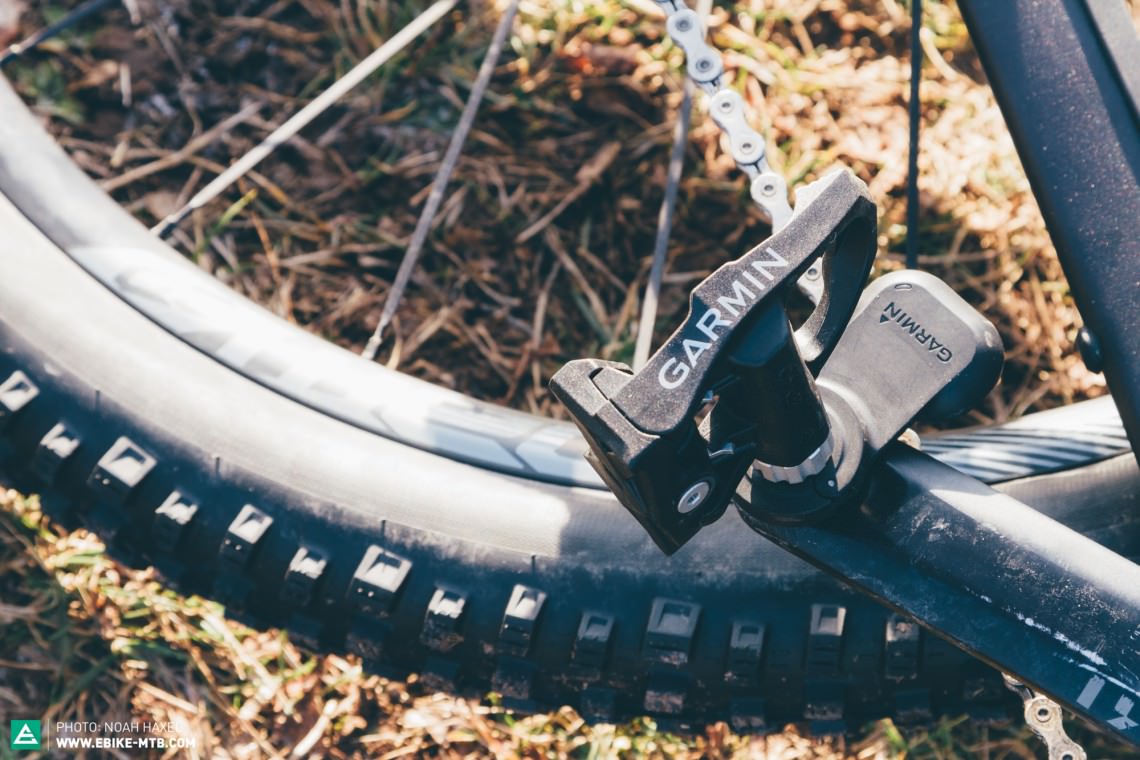 [emaillocker id=”11001″]
[emaillocker id=”11001″]
The Technology
Garmin kitted us out with all the crucial stats-collecting kit, we relied on the Vector 2 system to measure wattage. The Vector 2 pedals were the obvious solution for the sake of these comparisons, measuring power from the pedals instead of the cranks. Exclusively using one measuring system has ensured that we have valid and 100% comparable data from a conventional mountain bike (namely the Canyon Spectral) and an E-MTB (the Haibike XDURO NDURO Pro). We used Garmin Connect to analyse the data and filled in more than 2,000 Excel boxes before turning to a specialist in biomechanics to contribute to our data analysis.
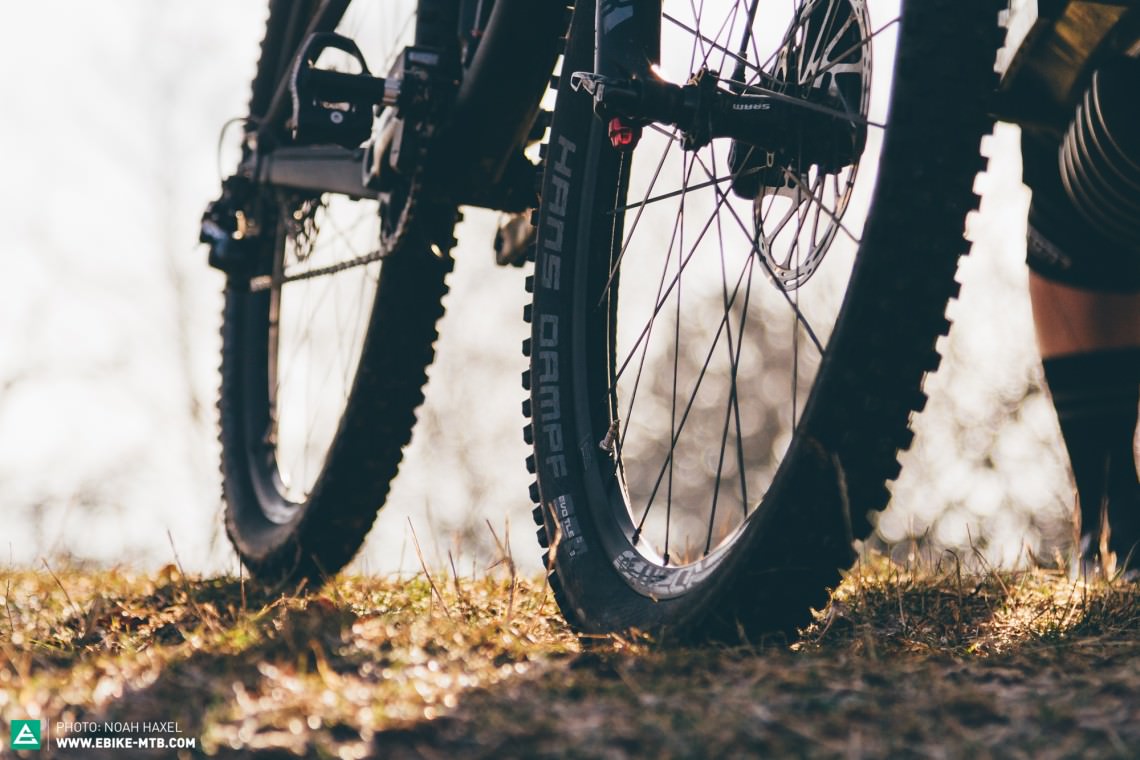
The Test Bikes
Two enduro bikes took on the responsibility as test bikes: first up, the Canyon Spectral, an agile bike with performance-focused geometry that’s used by riders at the Enduro World Series. The Haibike XDURO NDURO Pro 2016 stepped up as the aggressive E-MTB. Both bikes were kitted out with the same tyres for the purposes of the test. Given the substantial and incontestable differences in the bikes, we didn’t change any other features. After all, the Canyon Spectral EX tipped the scales at 12.84 kg, while the Haibike was no less than 22.8 kg. We were keen to find out exactly how big the gulf could be between these motorized and nonmotorized bikes.
The Test Team
Two different test riders (one former enduro racer and one amateur) completed the test loop three times in order to collect valid and consistent data.

The Test Route
Where’s the best place to achieve consistent results? Exactly, on the trails that you know as well as the back of your hands. That’s why we chose our home trails next to Stuttgart. The loop was 4.5 km in length, including a range of riding conditions: a steep tarmac climb followed by a steep trail uphill, then a gravel transfer stage and another short climb before the final technical trail descent with jumps, berms, and root gardens. To conclude the loop there was a final road section back to the start. Overall, this was a challenging route that demands a high level of fitness and notably high technical skills for mountain bikers – and definitely requires a skilled and dynamic riding style.
The Test Parameters
But what are the parameters for a comparison like this? Should it depend on the time taken for the loop? Heart rate? Watts? Naturally, none of these parameters would provide a satisfactory analysis on their own, but each one contributes to the reality, which is also impacted by motivation, one’s sense of wellbeing, and riding performance. As a result, we decided to use the defined comfort zone of the experienced test riders as the base data. On an E-MTB ride you’re not riding to your heart rate or your exerted watts – it’s about riding within your comfort zone, which varies depending on the section of the trail. Consequently, the riders rode the course at a pace that they considered doable and consistent without risking mistakes. The collected data and values are confirmation of their consistency.
The E-MTB was ridden in turbo mode. The watts refer to the riders’ exertion on the pedals. Depending on the cadence, the Bosch Performance CX motor supplies up to 300% additional support.
The Test Results and Findings
1. Section: Start
Distance: 240 m
Altitude difference: 0 m
Average gradient: 0 %
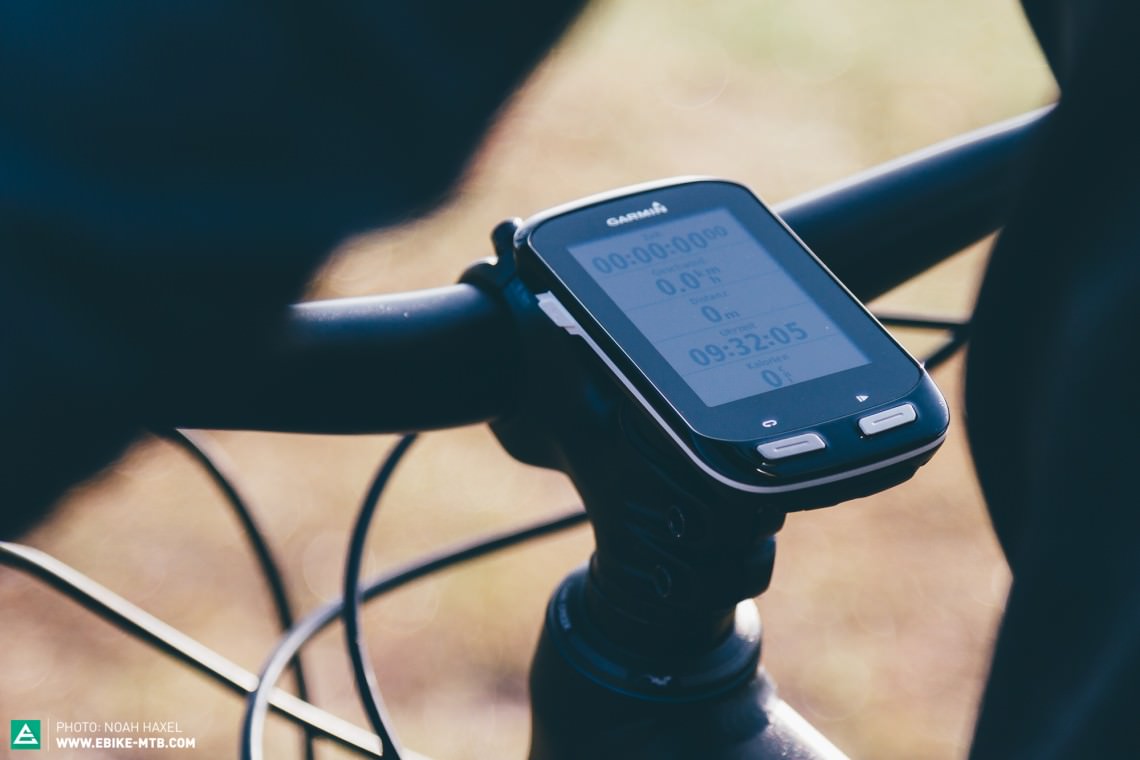
E-MTB vs. enduro (percentage difference):
Heart rate: -13 % lower Heart rate
Effort (Watts): -38 % less power
Cadence: +16 % higher Cadence
Speed: +47 % higher Average Speed
Explanation: the E-MTB accelerates significantly faster and reaches a higher speed in a shorter time despite the fact that the rider is exerting 38% less effort. However, 25 km/h is the limit.
2. Section: Uphill (Tarmac)
Distance: 350 m
Altitude difference: +33 m
Average gradient: 9,4 %
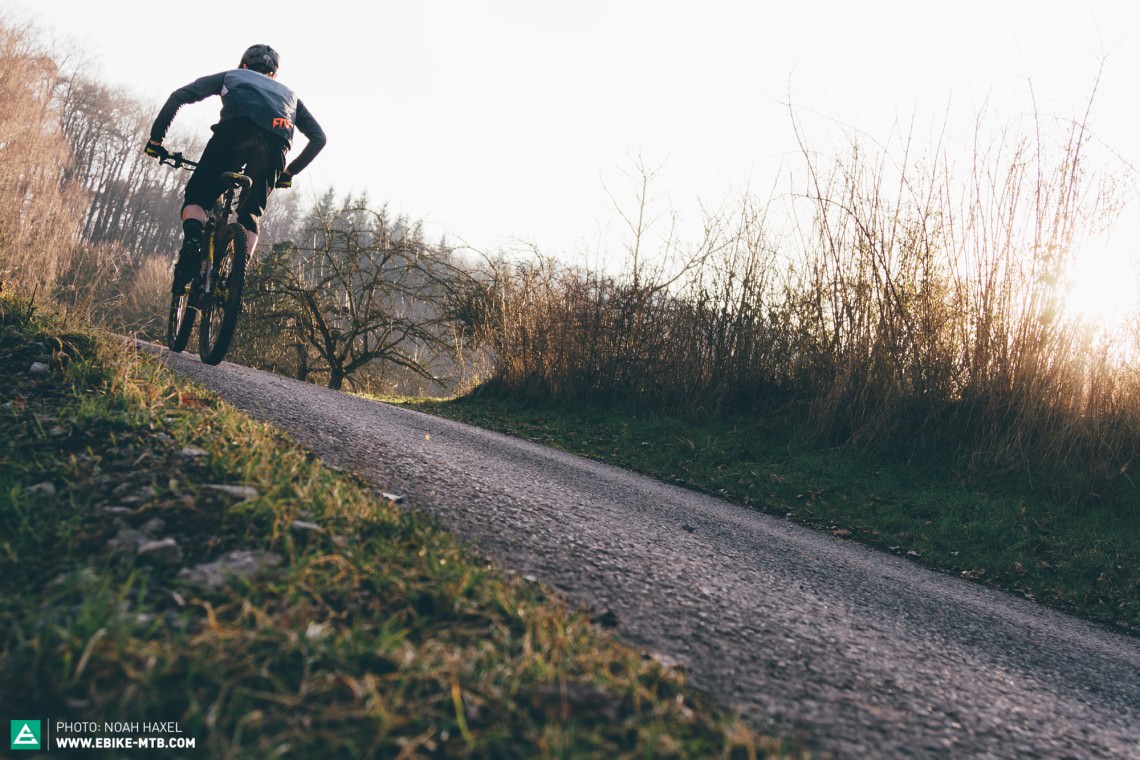
E-MTB vs. enduro (percentage difference):
Heart rate: -9 %
Effort (Watts): +4 %
Cadence: +22 %
Speed: +193 %
Explanation: The E-MTB displayed its strength on the climbs, with the motor encouraging the rider to pedal harder and faster in turbo mode. Depending on the cadence (and gearing), the motor delivers up to 300% assistance. On the E-MTB the riders even exerted a few more watts while riding at a lower heart rate, flying up the climb at three times the speed of the regular enduro bike (on which the tarmac climb is more of a hindrance). So even though it’s tarmac, this is where you’ll get the grin-inducing superman sense of the E-MTB.
3. Section: Uphill (Trail)
Distance: 550 m
Altitude difference: +68 m
Average gradient: 12,4 %

E-MTB vs. enduro (percentage difference):
Heart rate: -15 %
Effort (Watts): -29 %
Cadence: +39 %
Speed: +122 %
Explanation: This is where it gets exciting on the enduro bike: both riders’ heart rates shot up (at an average of 23 BPM higher), while on the E-MTB the heart rates remained virtually constant. This technical uphill included two ramps, with the first ramp including three consecutive steps that are approximately five metres apart. These take a certain amount of effort to overcome and the E-MTB’s motor is definitely advantageous in this situation, as it delivers the necessary speed to conquer the steps. Reaching the same sufficient speed on the mountain bike is substantially more demanding. On two occasions during the testing, the test riders were reduced to stepping off the mountain bike to overcome these obstacles.
However, the second ramp is proof that you cannot pedal as ‘mercilessly’ on such terrain on the E-MTB as on tarmac. Given the loose ground, some sensitivity is required in order to transfer the motor’s additional power from the tyres onto the ground; traction is decisive on loose or muddy ground, so a higher cadence (smaller gear) helps to prevent tyres from spinning fruitlessly. Depending on the terrain, it is often better to switch out of turbo mode too. However, the simple availability of the support still renders the E-MTB a better choice. Oh, and don’t forget that while the mountain bike riders wheeze their way up to the distant summit, the E-MTBers still get a decent dose of enjoyment despite the gradient!
4. Section: Flat (Gravel)
Distance: 1,020 m
Altitude difference: +10 m
Average gradient: 1 %
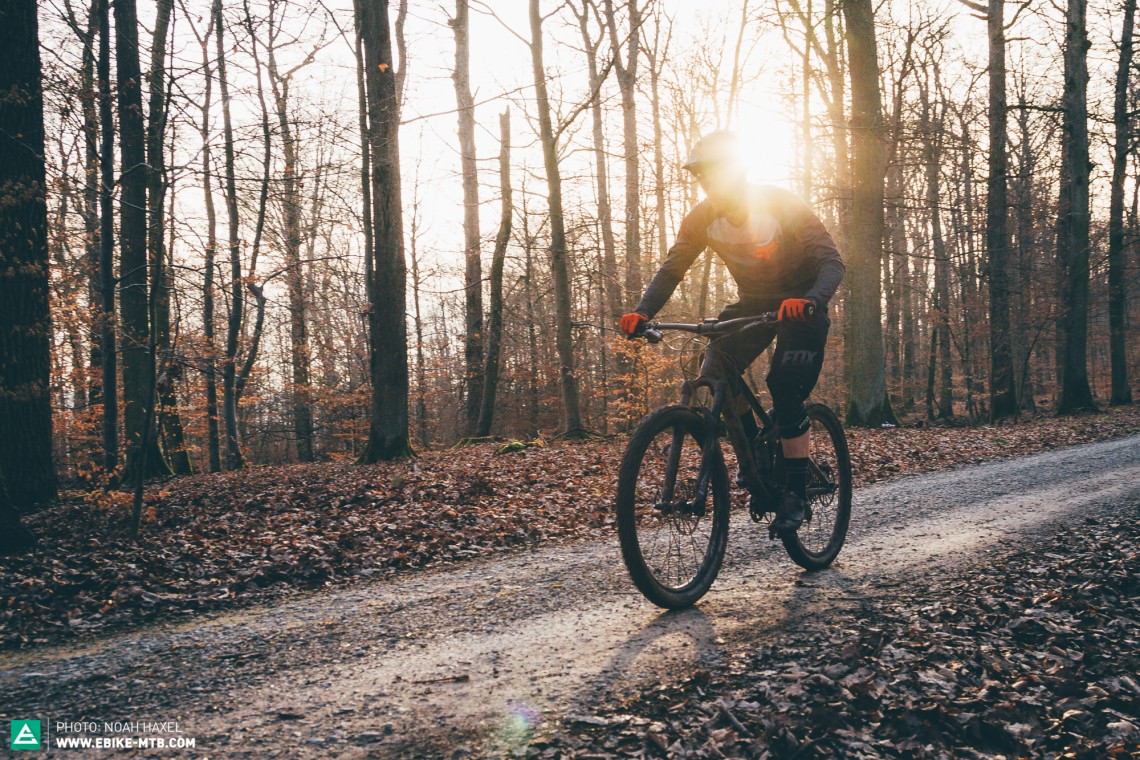
E-MTB vs. enduro (percentage difference):
Heart rate: -19 %
Effort (Watts): -34 %
Cadence: +11 %
Speed: +41 %
Explanation: While you ride at a faster pace in the turbo mode, the fun is limited to 25 km/h. Heart rate and effort are also significantly lower, making it quite a leisurely section.
5. Section: Uphill (Gravel/ Trail)
Distance: 140 m
Altitude difference: +14 m
Average gradient: 10 %
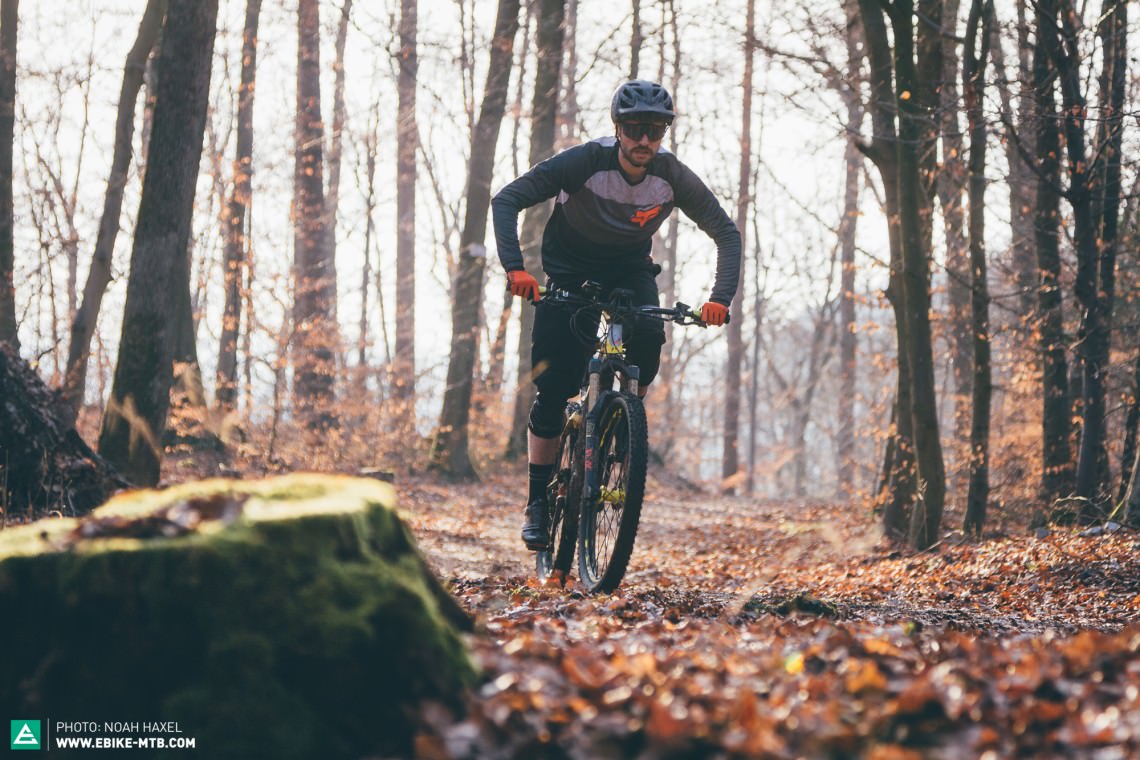
E-MTB vs. enduro (percentage difference):
Heart rate: -23 %
Effort (Watts): -45 %
Cadence: -7 %
Speed: +92 %
Explanation: Hard surfaces and a consistent uphill gradient make a difference: on mellow climbs like this one, there’s real uphill flow on the E-MTB and this section feels more like the trailhead – even though it goes uphill for another 140 metres before you reach the start of the downhill. On the mountain bike it’s a decent doable climb, but the fun factor is lacking.
6. Section: Downhill (Trail)
Distance: 530 m
Altitude difference: -117 m
Average gradient: -22 %
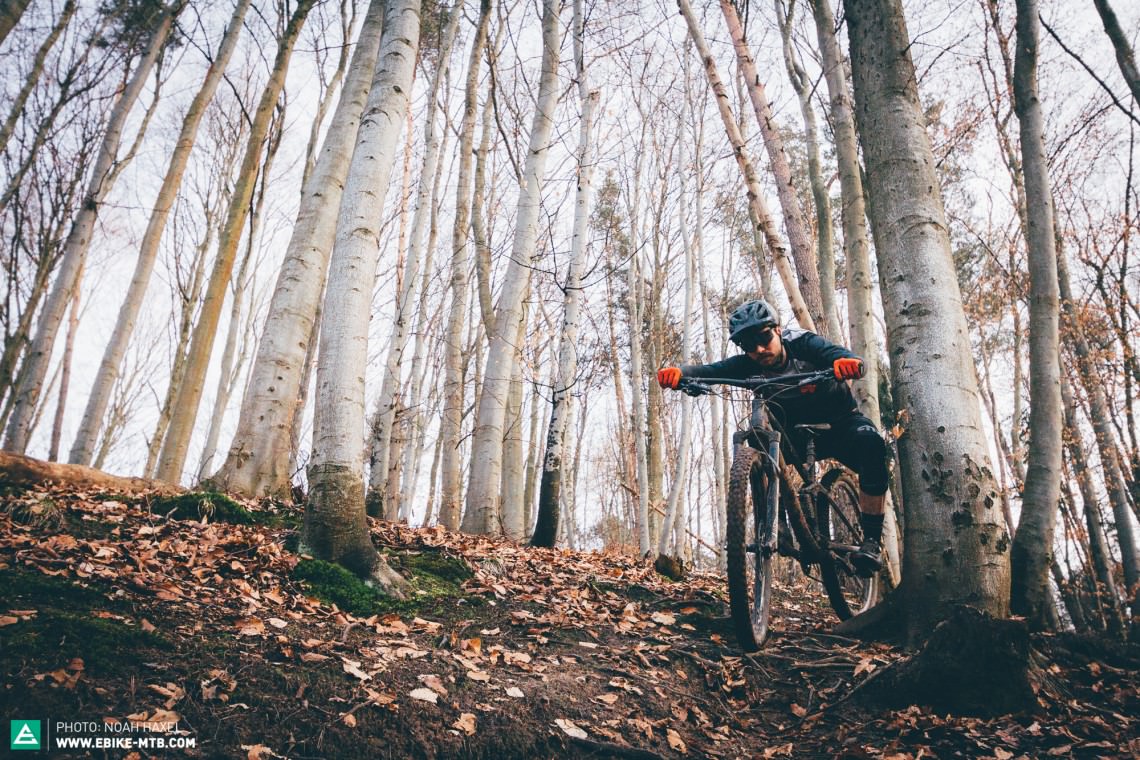
E-MTB vs. enduro (percentage difference):
Heart rate: -17 %
Effort (Watts): –
Cadence: –
Speed: -5 %
Explanation: The mountain bike is quicker on this section! However, the E-MTB has the trump card when it comes to off-camber sections and loose ground: it is more glued to the ground with its lower centre of gravity and heavier weight. Conversely, the mountain bike performs and handles significantly better when it is steep, twisty, and littered with jumps. Easier to maneuver, the regular mountain bike is also more responsive to braking and quicker to come to a halt. Moreover, hairpin bends proved much easier to get round, as the E-MTB’s rear wheel demands more power to align it into and out of the turn. This applies to all E-MTBs in general – given that you’re lugging around ten kg extra weight in corners and over obstacles, it demands full-body training. If you’ve ever ridden motocross, then you’ll know how exhausting it is to traverse off-road terrain with a heavy bike and a motor – it is a very different style of riding.
The effort (wattage) and cadence on downhills needs to be considered in separate sections: on steep and technical terrain, the mountain bike and E-MTB recorded equal data – after all, acceleration comes from letting go of the brakes. On the 30 m transfer section, the mountain bike had significantly higher wattage and cadence, as the short sprint section saw the rider go from almost 0 to maximum 22 km/h – the motor on the E-MTB provides full support in this instance. On the lower part of the downhill, which is littered with rideable berms, the E-MTB rider pedaled more. This is because the mountain bike’s handling is more precise and able to exploit and maintain a higher cornering speed..
It is therefore evident that handling plays a decisive role on downhills. The max speed of the E-MTB was also lower (- 9%) on the descent, as well as the max effort (- 45%). The E-MTB does ask you to pedal out of the berms to accelerate, but considering the low average pace (E-MTB 13.7 km/h), the rider gets the full support from the motor in turbo mode.
7. Section: Transfer (Asphalt)
Distance: 1.690 m
Altitude difference: -8 m
Average gradient: -0,5 %
E-MTB vs. enduro (percentage difference):
Heart rate: -16 %
Effort (Watts): -37 %
Cadence: -6 %
Speed: +28 %
Explanation:
The differences are minimal on this transfer section. This stems back to the higher speeds on the flat, as the E-MTB is regulated to 25 km/h.
Total Route:
Distance: 4,520 m
Altitude difference: 125 m
Time E-Mountainbike: 14:29 min
Average Speed E-Mountainbike: 18,64 km/h
Time Enduro: 21:40 min
Average Speed Enduro: 12,46 km/h
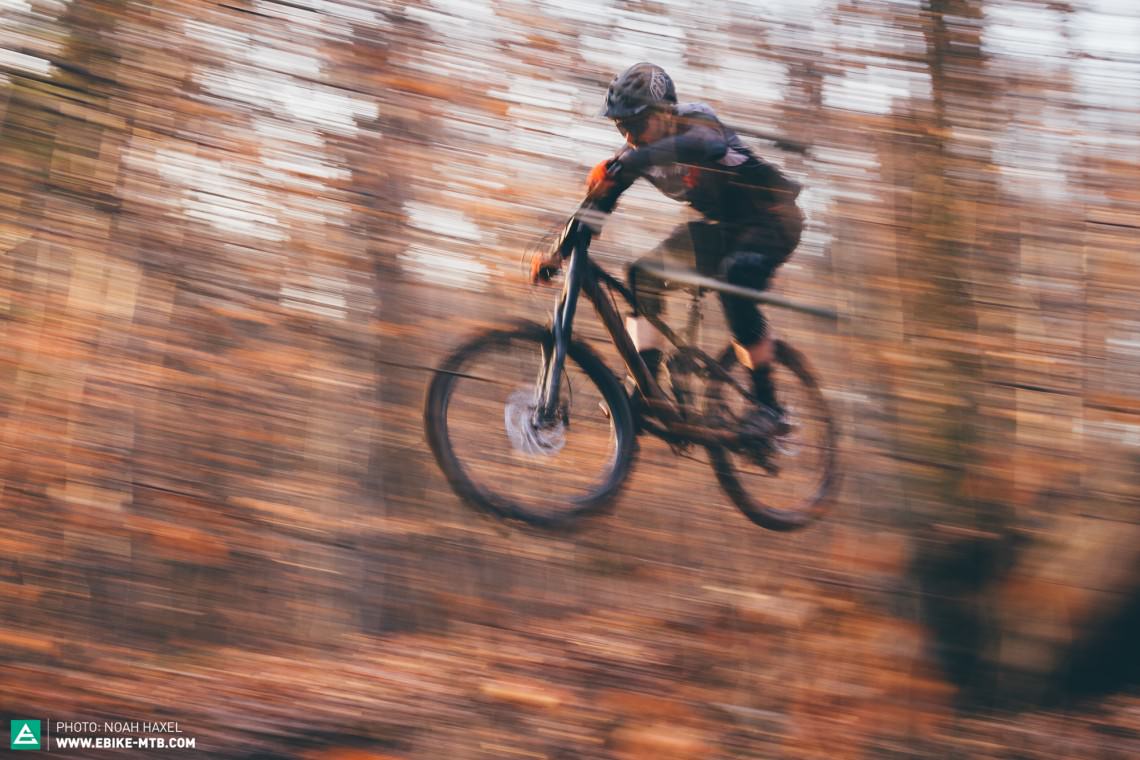
E-MTB vs. enduro (percentage difference):
Heart rate: -11 %
Effort (Watts): -40 %
Cadence: +5 %
Speed: +33 %
Explanation
1. More time for more trails
On regular mountain bikes, on a one-hour lunch ride the testers struggled to cover more than three loops – largely due to the steep climb and long transfer for just two minutes of downhill goodness. However, the E-MTB’s increased speed means you can ride four loops (and enjoy a nine-minute coffee or bakery pit-stop in the course of an hour). What’s more, the E-MTB rider will cover more distance on the trails and – thanks to the pedal assist – it’s easier to overcome momentary lapses of willpower and you’re potentially likely to spend more time on the bike. The route takes 22 minutes for a regular mountain bike, with 20 minutes just to cover the uphill and transfers, while the E-MTB can do the same in 12 minutes, including less effort.
2. More Fun
A conventional mountain bike prompts a more dynamic riding style due to its handling and lower weight, so depending on the nature of the trails and the skills of the rider, you’ll have more fun going downhill than on an E-MTB. But thanks to the lower centre of gravity and plusher feel of the ride, an E-MTB can feel more stable on flowing, wide trails. On off-camber sections and blown-out corners it definitely stays more planted. Given the motor, you can also pedal properly up the climbs despite longer travel and aggressive geometry. The matter of suspension efficiency is far less important when it comes to E-MTBs than it is for enduro bikes.
Up until now we’ve talked about two minutes’ worth of fun, but it’s interesting to note that the E-MTB permits fun for the entirety of the test loop. The uphills and transfers aren’t just easier, they’re also actually fun and doable (just think of the technical first ramp in the 3rd section’s climb). The transfer time is also significantly reduced, taking just 12 minutes instead of 20.
3. More Fitness and Training
The peaks in heart rate are less distinctive on an E-MTB, which is good news for many mountain bike pros who do their base training on the road bike. With the E-MTB you can transfer your base miles from the roads back to the trails. Another advantage comes from the consistently lower exertion, which will be beneficial for riders with health issues. If you suffer from issues with your joints or are at the age where you’d like to avoid potential problems, then an E-MTB may be a wiser choice. The 5% higher cadence at 40% lower wattage is proof of less impact on your joints (particularly knees and ankles) over the course of longer rides.

The Truth
Yes, we’re faster, we keep our heart rate more constant, and we can ride further on the trails in the same amount of time. Sincerely spoken, who wouldn’t love to be able to go faster and farther with less fatigue? If we consider only the hard line numbers of heart rate and power, then yes, from a scientific perspective, E-MTBs are cheating! But who are we trying to cheat? Ourselves? Just because we’re able to extract more fun from a shorter amount of time? Other people?
During our data collection, the test riders rode an additional turbo mode lap. But with a difference – they left their comfort zone far behind, and pumped up the pace to race pace. The result: riding in turbo doesn’t necessarily mean it’s easy – it can actually be a lot harder than riding at a comfortable speed on a normal mountain bike. Over this loop, the test riders inputted between 45% and 101% more watts compared to riding in their comfort zone in turbo mode. This put them up to 55% higher in terms of wattage output than on the regular mountain bike – particularly on the climbs. It might sound paradoxical, but it makes sense in reality: the higher level of support from the E-MTB prompts the rider to exert more effort on climbs. This is visible in the heart rate, which was even higher on the E-MTB than the regular mountain bike.
So that’s the facts: it’s not about what you do, but how you do it. On the E-MTB you can have an even more hardcore workout than on a regular mountain bike. However, this depends on your riding style. How you choose to ride is your own personal choice – and it should stay that way. The most important fact is that we all show mutual respect, enjoying our own riding and letting others enjoy theirs. Fun is the main factor – and with the E-MTB you can enjoy a full 14 minutes out of 14, and not just 2 minutes out of 22!
[/emaillocker]Words: Robin Schmitt Photos: Noah Haxel
Did you enjoy this article? If so, we would be stoked if you decide to support us with a monthly contribution. By becoming a supporter of E-MOUNTAINBIKE, you will help secure a sustainable future for high-quality cycling journalism. Click here to learn more.









